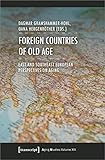Foreign Countries of Old Age : East and Southeast European Perspectives on Aging / ed. by Oana Hergenröther, Dagmar Gramshammer-Hohl.
Material type: TextSeries: Aging Studies ; 19Publisher: Bielefeld : transcript Verlag, [2021]Copyright date: ©2021Description: 1 online resource (390 p.)Content type:
TextSeries: Aging Studies ; 19Publisher: Bielefeld : transcript Verlag, [2021]Copyright date: ©2021Description: 1 online resource (390 p.)Content type: - 9783839445549
- Old age--Europe, Eastern
- Older people--Balkan Peninsula
- Older people--Europe, Eastern
- Ageism
- Aging Studies
- Aging
- Balkans
- Biopolitics
- Cultural History
- Culture
- Dementia
- Demography
- Eastern Europe
- Eastern European History
- Education
- Family
- History
- Intergenerational Relationships
- Literary Studies
- Literature
- Mythology
- Slavic Studies
- Society
- Southeastern Europe
- LITERARY CRITICISM / European / Eastern (see also Russian & Former Soviet Union)
- Ageism
- Aging Studies
- Aging
- Balkans
- Biopolitics
- Cultural History
- Culture
- Dementia
- Demography
- Eastern Europe
- Eastern European History
- Education
- Family
- History
- Intergenerational Relationships
- Literary Studies
- Literature
- Mythology
- Slavic Studies
- Society
- Southeastern Europe
- 300
- online - DeGruyter
| Item type | Current library | Call number | URL | Status | Notes | Barcode | |
|---|---|---|---|---|---|---|---|
 eBook
eBook
|
Biblioteca "Angelicum" Pont. Univ. S.Tommaso d'Aquino Nuvola online | online - DeGruyter (Browse shelf(Opens below)) | Online access | Not for loan (Accesso limitato) | Accesso per gli utenti autorizzati / Access for authorized users | (dgr)9783839445549 |
Frontmatter -- Contents -- Preface -- Introduction -- Historical Perspectives -- Old Age in the Balkans -- Co-Residence of Elderly Persons with Children and Grandchildren in Eastern and Southeast Europe -- “University Elders,” “Young Professors” and Students -- Changes in Soviet Academia’s Age-Related Personnel Policies during the Cold War -- Qualitative and Quantitative Inquiries -- No Country for Old People -- Meanings of Getting Old in Post-Transition Serbia -- On Nearness and Distance -- The Use of Information and Communication Technologies in Family Communication -- The Elderly in Russia -- Literary Representations -- Aging in Soviet Utopian and Dystopian Literature -- Ageless, Vital, Immortal -- Noticing Signs and Stereotypes of Aging -- Does Genre Matter? -- Traumatic Aging in Borisav Stanković and Miloš Crnjanski -- The Dark Past of Family -- The Hag and the Egg -- Commemorating Russia’s Great Old Women -- Contributors
restricted access online access with authorization star
http://purl.org/coar/access_right/c_16ec
The exploration of what May Sarton calls the »foreign country of old age« usually does not go far beyond the familiar: the focus of aging studies has thus far clearly rested upon North America and Western Europe. This multi-disciplinary essay collection critically examines conditions and representations of old age and aging in Eastern and Southeastern Europe from various perspectives of the humanities and social sciences. By shedding light on these culturally specific contexts, the contributions widen our understanding of the aging process in all its diversity and demonstrate that a shift in perspectives might in fact challenge a number of taken-for-granted positions and presumptions of aging studies.
Mode of access: Internet via World Wide Web.
In English.
Description based on online resource; title from PDF title page (publisher's Web site, viewed 25. Jun 2024)


